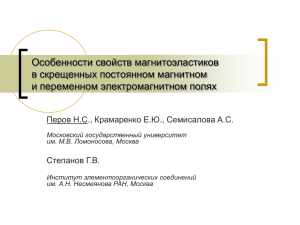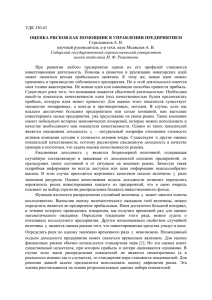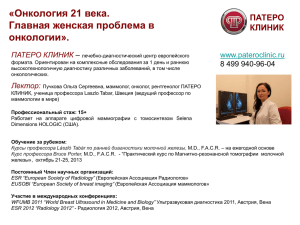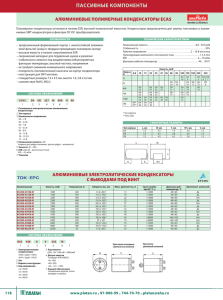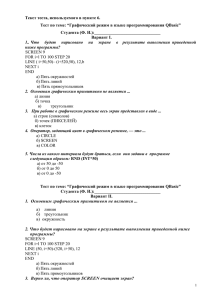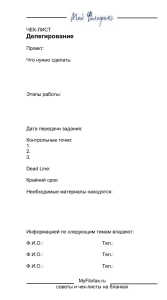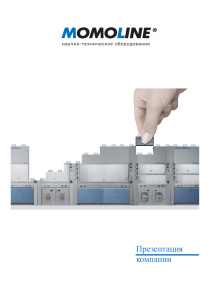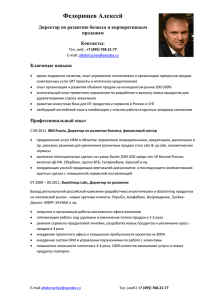Регулярный семинар аспирантов и молодых ученых КФТИ Вторник 15.00
реклама
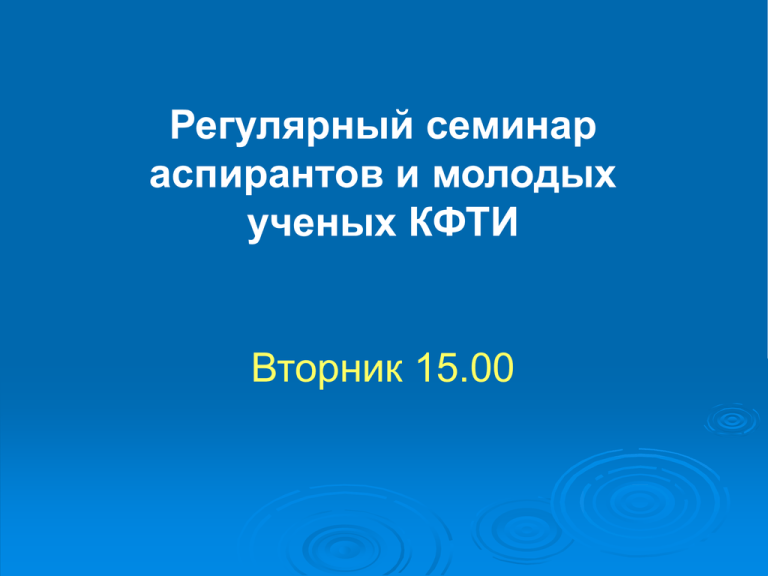
Регулярный семинар аспирантов и молодых ученых КФТИ Вторник 15.00 1.Цели и задачи 2.Структура докладов 3.Пожелания к презентациям 4.Обязательная информация при подготовке к докладу 5.Слушатели 1.Цели и задачи 1.Научиться выступать с докладами и делать презентации 2.Получить информацию о проблемах, объектах и методах 3.«Обкатать» выступления на конференциях, защитах и т.п. 4.Учебные лекции сотрудников института и гостей 2.Структура докладов 1.Заголовок, автор 2.План 3.Краткий обзор проблемы, мотивация 4.Описание исследуемой системы. 5.Используемый метод 6.Полученные результаты 7.Выводы 8.Заключение, планы, благодарности, список соавторов 2.Структура докладов 1.Заголовок, автор 2.План 3.Краткий обзор проблемы, мотивация 4.Описание исследуемой системы. 5.Используемый метод 6.Полученные результаты 7.Выводы 8.Заключение, планы, благодарности, список соавторов Leibniz Institute for Solid State and materials research Dresden Electron Spin Resonance in Vanadium Oxide Nanotubes (VOx-NT) Yulieth Cristina Arango, IFW-Dresden 2.Структура докладов 1.Заголовок, автор 2.План 3.Краткий обзор проблемы, мотивация 4.Описание исследуемой системы. 5.Используемый метод 6.Полученные результаты 7.Выводы 8.Заключение, планы, благодарности, список соавторов Outline ● Motivation ● Why VOx-NTs are interesting? ● Introduction ● Morphology and structure of VOx-NT ● Basic principles on ESR ● Experimental data and discussion ● VOx-NTs – Temperature dependence in ESR and comparison with magnetization data ● Influence of Lithium doping - ESR measurements ● Conclusions & Outlook 2.Структура докладов 1.Заголовок, автор 2.План 3.Краткий обзор проблемы, мотивация 4.Описание исследуемой системы. 5.Используемый метод 6.Полученные результаты 7.Выводы 8.Заключение, планы, благодарности, список соавторов Why VOx-NT becomes interesting Nanoscale magnetic materials novel aspects in magnetic structure and dynamic on the nanometer scale Mixed valence Nanoscale materials based on transition-metal (TM) oxide lowD structural units Strong electronic correlations in the spin and charge sectors VOx-NT and its character of mixed valence vanadium oxide coexistence of two valence states V4+ 3d1 and Configurations of a partially filled d-shell V5+ 3d0 ferromagnetism by doping with either electrons or holes 2.Структура докладов 1.Заголовок, автор 2.План 3.Краткий обзор проблемы, мотивация 4.Описание исследуемой системы. 5.Используемый метод 6.Полученные результаты 7.Выводы 8.Заключение, планы, благодарности, список соавторов Synthesis & Morphology TEM Hydrothermal procedure Multiwall NT + scroll TEM image of VOx-NT VOx-layer Outer diameter: Range from 50 to 100 nm Organic molecules Dodecylamine, C12H25NH2 Inner diameters: Between 20 and 30 nm Structure side view O V V Electron diffraction pattern Two dimensional quasi-tetragonal cell Similar structure in BaV7O16 x nH2O O Distorted octahedron tetrahedron V7O16 layer edge-sharing VO-Octahedra coupled in zig- zag chains isolated VO-Tetrahedra Vanadium valence VO2 V 2p V4+ Binding energy in-between V2O5 Increase in the number of the 3d electrons V5+ V4.4+ mixed valency downshift the binding energy Expected: Core level photoemission(XPS) data from the V 2p levels of VOx-NT Found: (Magnetization and 60% V4+ [3d1] , magnetic (S = ½) 40% V5+ [3d0] , non-magnetic (S = 0) NMR measurements) 14% free spins Tetrahedral coordination + 28% spins coupled in dimers + 18% spins coupled in trimers Octahedral coordination } 2.Структура докладов 1.Заголовок, автор 2.План 3.Краткий обзор проблемы, мотивация 4.Описание исследуемой системы. 5.Используемый метод 6.Полученные результаты 7.Выводы 8.Заключение, планы, благодарности, список соавторов Electron Spin Resonance ESR Energy 1 g B B 2 RF-induced transition Absorption: P h B0 1 g B B 2 dP/dH H0 Increasing magnetic field B Electron magnetic moment e g BS Spin angular momentum 1 S z ms , ms 2 Zeeman Energy: Describes the Interaction between the spin and the field. The energy separation the two spin states: of 1 U B g B B 2 Hres: Linewidth: Area: g-factor Spin-spin interaction Spin susceptibility Effective magnetic field experienced by each electron H H 0 Lˆ.Sˆ H cf H Z AIˆ.Sˆ Electron-electron interaction Spin-orbit coupling Crystal field V4+ in cubic symmetry free Vanadium Zeeman interaction Hiperfine Coupling V4+ in tetragonal symmetry [3d1], S=1/2 V: [Ar] 3d3 4s2 O O 3d Energy V V V b1t a1t eg x2-y2 3z2-r2 x2-y2 3z2-r2 2L+1 = 5 b2t xy t2g xy xz yz et xz yz 2.Структура докладов 1.Заголовок, автор 2.План 3.Краткий обзор проблемы, мотивация 4.Описание исследуемой системы. 5.Используемый метод 6.Полученные результаты 7.Выводы 8.Заключение, планы, благодарности, список соавторов ESR Signal from VOx-Nanotubes 10 Line 1: Experiment g = 2.00 T=300 K free spins Total Fit 1 dP/dH (a.u.) 5 g X-band ESR 9.52 GHz Field = 0 G to 9000 G Two Lorentzian lines 2 0 -5 Two nonequivalent magnetic V4+ (S = 1/2) sites g Line 2: 1 g = 1.97 2 trimers -10 dimers at high temp. 2000 3000 Field (G) 4000 5000 Line 1: Individual V spins in tetrahedral positions Line 2: spin trimers and thermally excite spin dimers in distorted octahedral positions Inv.Area(norm. RT) - (a.u) Quasi-free spins in V(3)-sites 2.8 quasi-free spins 2.4 14 % (broad line) 2.0 1.6 dimers trimers 1.2 Dimers in the chains High temperature 28 % (narrow line) 0.8 Trimers in the chains ESR 0.4 0.0 0 50 100 150 18 % Magnetization = 4.4 K 200 Temperature (K) 250 300 800 Narrow line 700 Broad line Broad line 600 2.04 500 quasi-free spins quasi-free spins 400 g-factor Linewidth (G) Narrow line 2.06 trimers 300 trimers 2.02 2.00 200 dimers 1.98 100 dimers 1.96 0 0 50 100 150 200 Temperature (K) 250 300 0 50 100 150 200 Temperature (K) 250 300 2.Структура докладов 1.Заголовок, автор 2.План 3.Краткий обзор проблемы, мотивация 4.Описание исследуемой системы. 5.Используемый метод 6.Полученные результаты 7.Выводы 8.Заключение, планы, благодарности, список соавторов Conclusions Undoped VOx-NTs: Different spin species identified by ESR - Individual spins Equal amount - Trimers } - Dimers Thermally activated above 100 K Good agreement with Magnetization measurements and NMR Li-doped VOx-NTs: Focus on the Ferromagnetic sample Li = 0.1 - Individual spins and trimers present - Dimers do not survive - Additional narrow line Ferromagnetic resonance ?? 2.Структура докладов 1.Заголовок, автор 2.План 3.Краткий обзор проблемы, мотивация 4.Описание исследуемой системы. 5.Используемый метод 6.Полученные результаты 7.Выводы 8.Заключение, планы, благодарности, список соавторов Outlook - Determine Li position (X-rays) - Spin dynamics vs. Lithium concentration by ESR - Confront ferromagnetism - ESR on newly prepared samples - High field ESR (Good spectral resolution) and NMR Acknowledgements B. Büchner, V. Kataev Christian, Ferenc, Uwe and Mohammed from the ESR group Christine Täschner, Andreia Ioana Rüdiger Klingeler, Ingo Hellmann, Vavilova Popa, Jenia Financial support by the Alban Office 3.Пожелания к презентациям 1.Больше наглядной информации 2.Выделяйте главное 3.Не увлекайтесь подробностями и деталями, малопонятными неспециалисту. 4.Объясняйте «то, что всем известно» На Вашем докладе Вы – лектор, мы – студенты, расскажите так, чтоб было понятно студенту. ESR Signal from VOx-Nanotubes 10 Experiment dP/dH (a.u.) T=300 K Total Fit 5 0 -5 -10 2000 3000 Field (G) 4000 5000 ESR Signal from VOx-Nanotubes 10 Experiment dP/dH (a.u.) T=300 K Total Fit 5 X-band ESR 9.52 GHz Field = 0 G to 9000 G Two Lorentzian lines 0 Two nonequivalent magnetic V4+ (S = 1/2) sites -5 -10 2000 3000 Field (G) 4000 Line 1: g=2.0 Individual V spins in tetrahedral positions Line 2: g=1.97 spin trimers and thermally excite spin dimers in distorted octahedral positions 5000 ESR Signal from VOx-Nanotubes 10 Line 1: Experiment g = 2.00 T=300 K free spins Total Fit 1 dP/dH (a.u.) 5 g X-band ESR 9.52 GHz Field = 0 G to 9000 G Two Lorentzian lines 2 0 -5 Two nonequivalent magnetic V4+ (S = 1/2) sites g Line 2: 1 g = 1.97 2 trimers -10 dimers at high temp. 2000 3000 Field (G) 4000 5000 Line 1: Individual V spins in tetrahedral positions Line 2: spin trimers and thermally excite spin dimers in distorted octahedral positions 4.Обязательная информация при подготовке к докладу Не позже, чем за неделю до семинара: 1.Название доклада 2.Лаборатория, отдел, группа 3.Фамилия, координаты руководителя 4.Кандидаты в зрители 5. Краткое CV [email protected] [email protected] [email protected] 5.Слушатели 1.Во время доклада – только технические вопросы. 2.После доклада – максимум вопросов! Вы здесь, чтоб узнать новое! 3.После вопросов и ответов – замечания, мнения и пожелания по поводу представления доклада. 5.Слушатели 30-45 минут!!! Спасибо за внимание! До встречи 07.10 в 15:30
